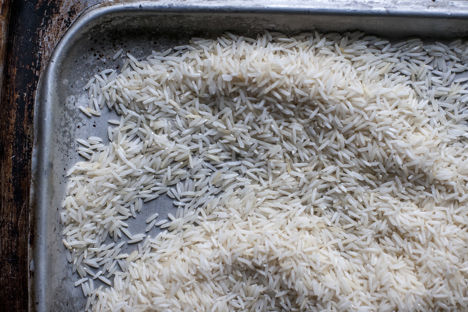One of the things that can make cooking rice intimidating is that, unlike pasta, different shapes of rice cook very differently. While penne, spaghetti and rigatoni all simply need to be added to plenty of salted boiling water and cooked until al dente, basmati rice, jasmine rice, golden sella rice and Japanese short grain rice all have very different cooking styles and traditions. This article will focus on several types of rice found in the U.K. – long grain rice, basmati rice, jasmine rice and easy cook rice.
While basmati and jasmine rice are both types of long grain rice, ‘long grain’ rice tends to be associated with poorer quality grains, and rice available under this umbrella term is often sold at a lower price, for example, under supermarket own brand labels. Buying specific varieties of rice is therefore a way to ensure authenticity and to guarantee that you’re buying the best quality possible.
What is long grain rice?
Rice is generally categorised by the size of the grain: sushi rice is short grain, arborio rice is medium grain and basmati is long grain. The rather vaguely named long grain rice in the UK isn’t one specific varietal, and so varies a fair amount from brand to brand. Generally though, this is the sort of ‘standard’ rice most people think of when they think of rice. It’s not as sticky or plump as Thai jasmine rice or as toothsome and svelte as basmati. It’s somewhere in the middle.
What is basmati rice?
Basmati rice, typically grown across the Indian subcontinent, is one of the highest quality varieties of long-grain rice, celebrated for its distinctly toasty, nutty aroma. In fact, the word ‘basmati’ derives from the sanskrit word vasmati, meaning ‘fragrant’. It has long, slender grains (typically 6-8mm) which, when cooked correctly - are light and fluffy.
What is jasmine rice?
Jasmine rice is another variety of high-quality of long-grain rice, particularly revered for its fragrance - described as like popcorn or pandan leaf - and its slightly sweet flavour. Cooking a pot of jasmine rice will fill the room with its unique aroma. Its texture is also noticeably different from long grain rice in that it is slightly stickier (although much less so than glutinous rice, which is prized for its intensely sticky texture).
What is easy cook rice?
Easy cook rice is also a long grain rice, but it’s long grain rice that has been parboiled. Parboiling rice involves boiling the rice while still in its husks and then fully drying it out again. Now parboiled rice is prepared using an industrial process where it is also vacuum dried before and after the boiling stage.
Easy cook rice is so-called because it doesn’t stick together like non-parboiled rice. Instead, the grains behave more like wild rice or farro, each one stays quite separate from the other. The parboiling process gives the rice grains a yellow, transluscent appearance. Easy cook rice has a much firmer texture than regular rice, and won’t soften and collapse in the same way. This makes it great for dishes where you want the grains to remain distinct, but a poor choice for rice pudding or congee.
As we’ll get into below, easy cook rice and long grain rice cook differently. Occasionally rice labelled as ‘long grain rice’ will in fact have been parboiled. It’s best to check the ingredients section to confirm which type is actually in the packet.
Can you cook rice like pasta?
Packets of long grain rice in the U.K. typically recommend that you cook it like pasta. That is, to cook the rice in plenty of boiling water and then drain it. If using parboiled rice, cooking it in plenty of boiling water works well to produce rice that is very separate and non-starchy, and after 15 minutes it’s still toothsome and bouncy. But for softer, more starchy non-parboiled rice, this method doesn’t work quite as well.
While some cooking times for long grain rice suggest boiling it for 10 minutes, others suggest doing so for up to 15 minutes. Boiling standard rice for 15 minutes will almost certainly cause the rice to break down and begin to turn mushy. Not rinsing the rice and then using insufficient water can also make non-parboiled rice extremely starchy.
As a result it’s better to follow the absorption method for cooking regular rice. If you’d really prefer to cook rice like pasta, make sure to cook it in plenty of water and to only cook it for 10–12 minutes.
How do you cook rice by the absorption method?
Cooking rice in an amount of water that should be entirely absorbed by the rice as it cooks is sometimes called the ‘absorption method’. The exact amount of water you want to add varies from batch to batch, depending on whether you cover the pan with a lid, how high the heat on the pan is, the size of the pan and the quantity of rice. All of this can make cooking rice sound pretty intimidating! Luckily there’s more room for error than you might expect.
One of the first things to note is that if cooking rice by the absorption method then the size of the pan has an impact on the results. If you cook 100g pasta in a small pan then you will get the same results as if you cooked 100g pasta in a big pan. But the same isn’t true of rice. With rice, it’s much harder to cook small quantities in a very large pan.
You generally want to have slightly more water than rice by volume, or enough so that the water rises above the top of the rice by a centimetre or so. If the size of your pan means you need to use a lot more water than rice, it’s probably best to cook more rice or use a smaller pan.
How to cook long grain white rice
Metric
Imperial
- 150g of long grain rice, rinsed, about 3/4 cup or 180ml
- 230ml of water, about 1 cup
Add rice to a medium-sized heavy-bottomed pot with a tight-fitting lid
Add the water to the pot. It should cover the rice by about 1 cm
Cover the pot with a lid and bring to a simmer. Once at a simmer, turn the heat down to low and cook for 12–15 minutes, or until all the water is absorbed
Turn off the heat but don't remove the lid. Let the rice steam for about 10 more minutes, or until plump and tender. Gently mix the rice with a rice paddle or rubber spatula
Note: In some cuisines, like Japanese and Korean, rice is traditionally unsalted so it balances out the salty dishes it accompanies. Season your rice according to your own preferences, bearing in mind what dishes it will be paired with
How to cook basmati rice
Learn how to cook this aromatic grain correctly using our simple guide below.
How to cook jasmine rice
Learn how to cook jasmine rice correctly to get the most out of this high quality, floral grain by watching our easy to follow video guide.
Do you need to wash rice?
While for some dishes the starch on the outside of rice grains is needed – like risottos and rice pudding – when cooking standard long grain rice this starch can make the rice very gluey. It’s best to rinse rice a few times to get rid of this outer layer of starch.
Add the rice to a pan or bowl with plenty of water. Gently scrunch the rice around in the water with your hand, and then pour it off, being careful not to lose any grains of rice. Repeat this process three or four times. Some recipes will say ‘until the water runs clear’, but the truth is that there will likely always be a little bit of starch left in the water, and just rinsing it three or so times is normally enough to avoid any unpleasant textures.
Do you need to soak rice?
Soaking rice shortens the cooking time, and makes the resulting rice slightly softer. It’s not necessary for white rice, but if cooking very fragrant rice – like high quality basmati or jasmine rice – it might be worth it, as the short cooking time helps preserve the fragrance.
How do you cook rice in a rice cooker?
Rice cookers range from less than £40 to almost £400, and the more advanced models come with lots of features which can make them a little bit overwhelming. More advanced models have settings for adjusting the hardness or softness of the rice, for cooking brown rice or congee, and even for making cakes. Once you’ve mastered the basics though, using a rice cooker makes cooking rice incredibly easy.
The basic method for using a rice cooker is to first measure how much rice you want using the 180ml plastic cup provided. One cup is 150g rice, and one serving is about half to three quarters of a cup. Add the rice to the bowl of the rice cooker and then rinse it using the directions above. Drain off all the water, but leave the rice in the bowl.
Fill the water to the line on the inside that matches the cups of rice you added, e.g. ‘2’ for 2 cups. Place your rice in the machine and press go – the rice cooker will tick over to keep warm once your rice is ready.
Get in touch
Please sign in or register to send a comment to Great British Chefs.




